Learning Objectives
An activity and discussion that will provide:
- Opportunity to get to know fellow participants and trainers
- An introduction to variation in thinking preferences
- Discuss about important norms and polices when working in research teams
4.1 Thinking Preferences Activity
Step 1:
- Don’t read ahead!! We’re headed to the patio.
4.1.1 About the Whole Brain Thinking System
Everyone thinks differently. The way individuals think guides the way they work, and the way groups of individuals think guides how teams work. Understanding thinking preferences facilitates effective collaboration and team work.
The Whole Brain Model, developed by Ned Herrmann, builds upon early conceptualizations of brain functioning. For example, the left and right hemispheres were thought to be associated with different types of information processing while our neocortex and limbic system would regulate different functions and behaviours.
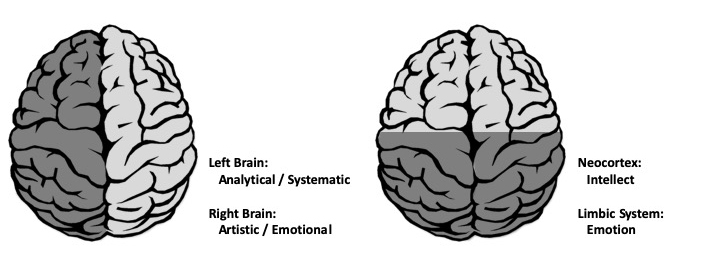
The Herrmann Brain Dominance Instrument (HBDI) provides insight into dominant characteristics based on thinking preferences. There are four major thinking styles that reflect the left cerebral, left limbic, right cerebral and right limbic.
- Analytical (Blue)
- Practical (Green)
- Relational (Red)
- Experimental (Yellow)
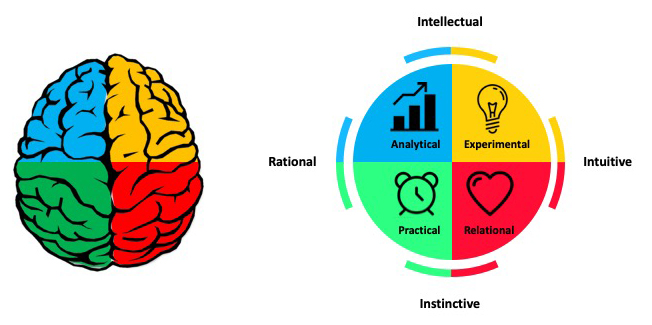
These four thinking styles are characterized by different traits. Those in the BLUE quadrant have a strong logical and rational side. They analyze information and may be technical in their approach to problems. They are interested in the ‘what’ of a situation. Those in the GREEN quadrant have a strong organizational and sequential side. They like to plan details and are methodical in their approach. They are interested in the ‘when’ of a situation. The RED quadrant includes those that are feelings-based in their apporach. They have strong interpersonal skills and are good communicators. They are interested in the ‘who’ of a situation. Those in the YELLOW quadrant are ideas people. They are imaginative, conceptual thinkers that explore outside the box. Yellows are interested in the ‘why’ of a situation.
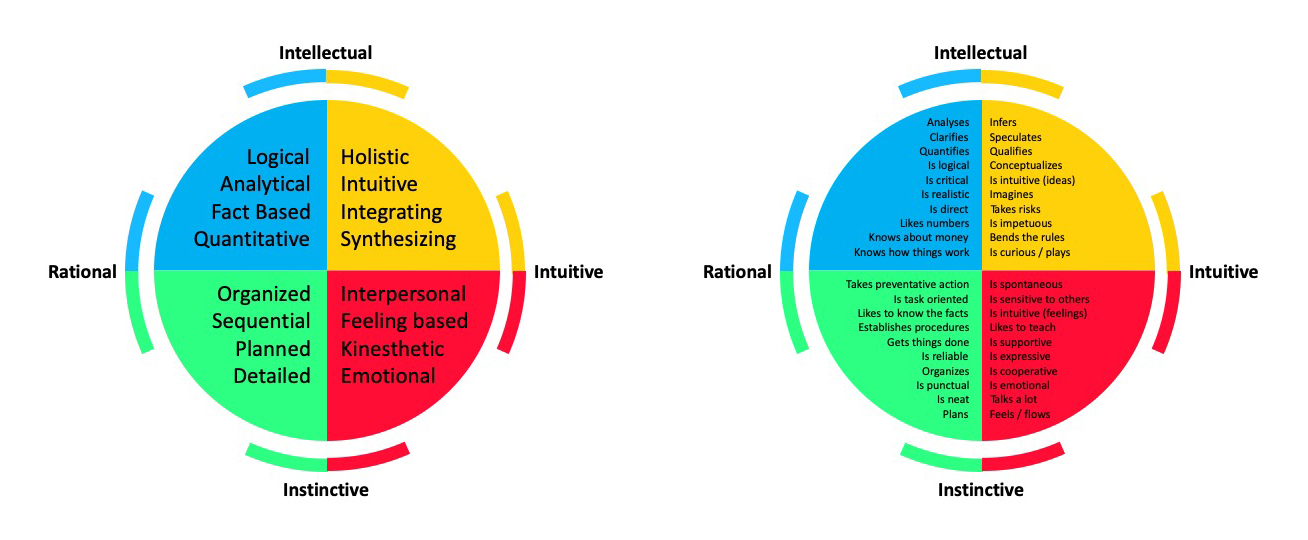
Most of us identify with thinking styles in more than one quadrant and these different thinking preferences reflect a complex self made up of our rational, theoretical self; our ordered, safekeeping self; our emotional, interpersonal self; and our imaginitive, experimental self.
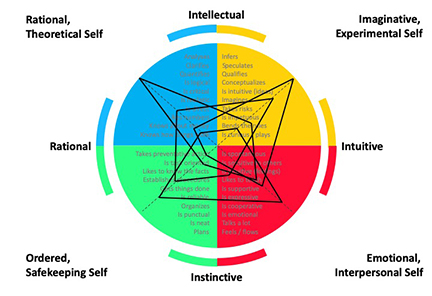
Understanding the complexity of how people think and process information helps us understand not only our own approach to problem solving, but also how individuals within a team can contribute. There is great value in diversity of thinking styles within collaborative teams, each type bringing strengths to different aspects of project development.
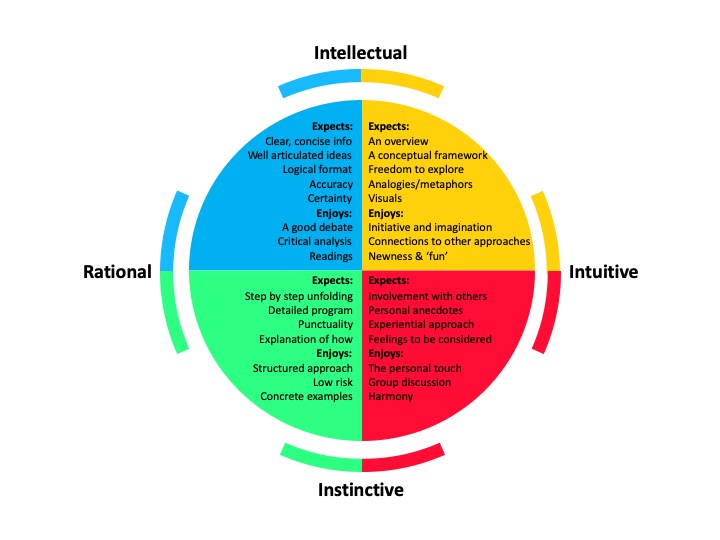
4.1.2 Bonus Activity
Step 1:
- Read through the statements contained within this document and determine which descriptors are most like you. Make a note of them.
- Review the descriptors again and determine which are quite like you.
- You are working towards identifying your top 20. If you have more than 20, discard the descriptors that resonate the least.
- Using the letter codes in the right hand column, count the number of descriptors that fall into the categories A B C and D.
Step 2:
- Scroll to the second page and copy the graphic onto a piece of paper, completing the quadrant with your scores for A, B, C and D.
Step 3:
- Reflect and share out: Do you have a dominant letter? Were some of the statements you included in your top 20 easier to resonate with than others? Were you answering based on how you are or how you wish to be?
4.2 Developing a Code of Conduct
Whether you are joining a lab group or establishing a new collaboration, articulating a set of shared agreements about how people in the group will treat each other will help create the conditions for successful collaboration. If agreements or a code of conduct do not yet exist, invite a conversation among all members to create them. Co-creation of a code of conduct will foster collaboration and engagement as a process in and of itself, and is important to ensure all voices heard such that your code of conduct represents the perspectives of your community. If a code of conduct already exists, and your community will be a long-acting collaboration, you might consider revising the code of conduct. Having your group ‘sign off’ on the code of conduct, whether revised or not, supports adoption of the principles.
For example, the Openscapes code of conduct includes
- Be respectful
- Be direct but professional
- Be inclusive
- Understand different perspectives
- Appreciate and Accommodate Our Similarities and Differences
- Lead by Example
Understand Different Perspectives
Our goal should not be to “win” every disagreement or argument. A more productive goal is to be open to ideas that make our own ideas better. Strive to be an example for inclusive thinking. “Winning” is when different perspectives make our work richer and stronger. (openscapes.org)
Below are other example codes of conduct:
4.4 Data Sharing and Reuse Policies
As with authorship agreements, it is valuable to establish a shared agreement around handling of data when embarking on collaborative projects. Data collected as part of a funded research activity will typically have been managed as part of the Data Management Plan (DMP) associated with that project. However, collaborative research brings together data from across research projects with different data management plans and can include publicly accessible data from repositories where no management plan is available. For these reasons, a discussion and agreement around the handling of data brought into and resulting from the collaboration is warranted and management of this new data may benefit from going through a data management planning process. Below we discuss example data agreements.
The example data policy template provided by the Arctic Data Center addresses three categories of data.
- Individual data not in the public domain
- Individual data with public access
- Derived data resulting from the project
For the first category, the agreement considers conditions under which those data may be used and permissions associated with use. It also addresses access and sharing. In the case of individual, publicly accessible data, the agreement stipulates that the team will abide by the attribution and usage policies that the data were published under, noting how those requirements we met. In the case of derived data, the agreement reads similar to a DMP with consideration of making the data public; management, documentation and archiving; pre-publication sharing; and public sharing and attribution. As research data objects receive a persistent identifier (PID), often a DOI, there are citable objects and consideration should be given to authorship of data, as with articles.
The following example lab policy from the Wolkovich Lab combines data management practices with authorship guidelines and data sharing agreements. It provides a lot of detail about how this lab approaches data use, attribution and authorship.
Below an example from Wolkovich’s Lab Data Management Policies, Section 6: Co-authorship & data.
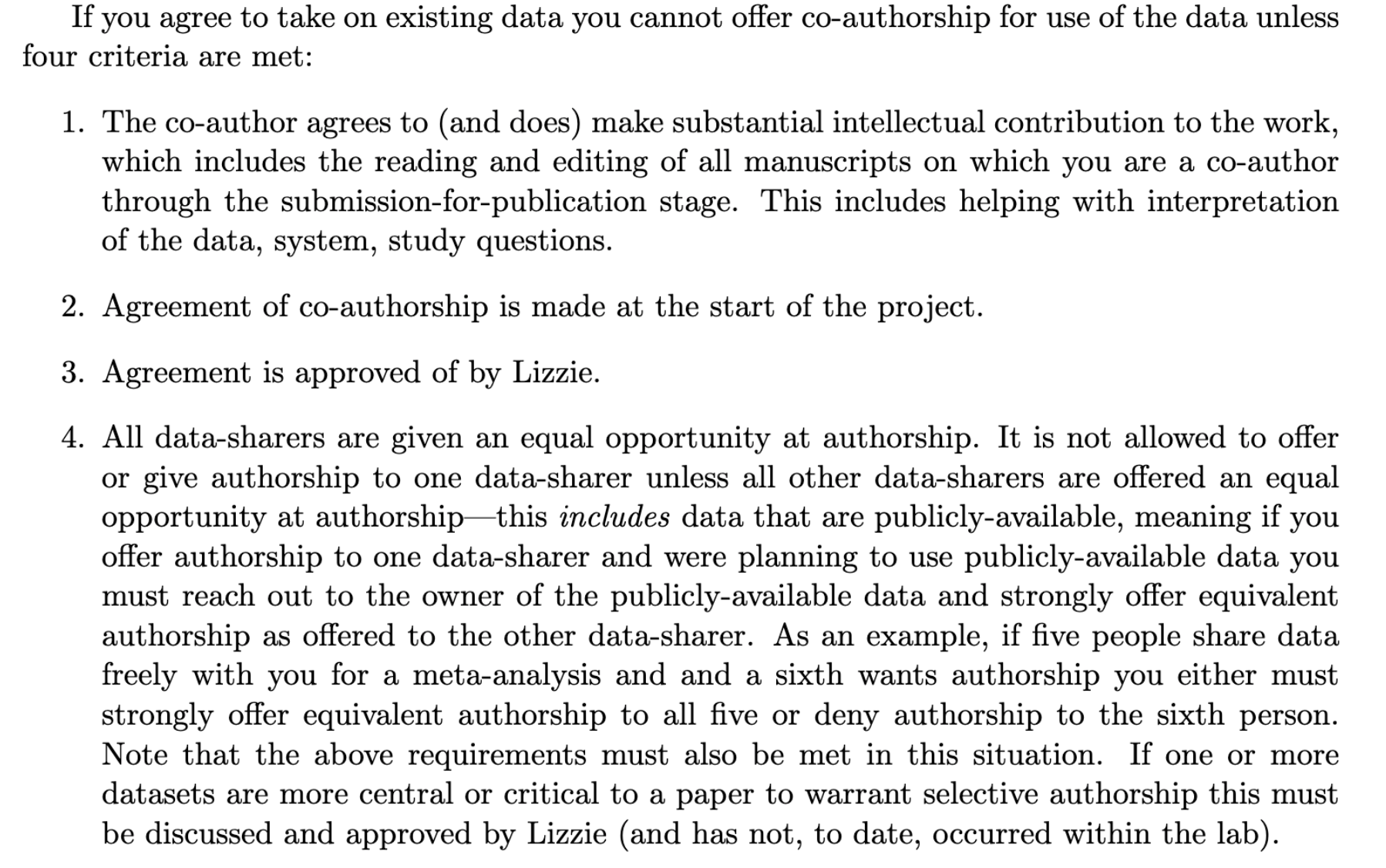
Data Management Policies for the Wolkovich Lab - Preview
This policy is communicated with all incoming lab members, from undergraduate to postdocs and visiting scholars, and is shared here with permission from Dr Elizabeth Wolkovich.
